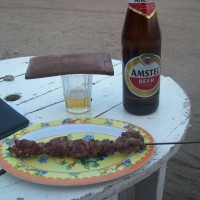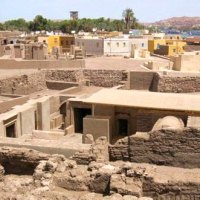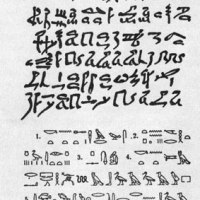Shea butter, a vegetable butter made from the nuts of an African tree, is known throughout the West. A while back I talked about it in this blog.
There are other works by colonial explorers that mention vegetable butters, some of which may also be shea – others, may be vegetable butter made from other types of trees. Here are several:

Sheanut trees and millet – a good agroforestry combination in semiarid regions. Source: agroforestry parkland
From: Caillie, Travels through Central Africa to Timbuctoo. 1830:
In Mandingo country, West Africa: The first product is unidentified, but the second sounds as if it could be shea butter:
… For a few glass beads, I readily procured vegetable butter, called in the country c^,which, though collected in abundance, is not much eaten by the inhabitants as they prefer selling it. This butter is tolerably good; but it is necessary to cook it with the food with which it is eaten otherwise its flavour is not very agreeable. The natives use it for pains and sores.
… I have seen in the country a tree which like the c^ produces a butyraceous substance; it is called by the natives taman. The butter of this tree is of a yellow colour, like ours. It is firm, notwithstanding the heat of the climate, and does not contract any bad flavour. 1 liked it better than the butter of the c^, which is less firm, and of an ash colour. However, the natives assured me that the produce of the c^ is more wholesome than that of the taman, and I saw many who would not eat the latter, alleging that it made them ill. For my part, I frequently ate it and never experienced any bad effect from it.
Another possible site where shea butter trees grow is described by Baker, about 30 years later, in North central Africa during his searches for the Nile Sources (current-day northern Uganda / southern Sudan):
From: Baker, The Albert N’Yanza, Great Basin of the Nile And Explorations of the Nile Sources. 1861-65), by Sir Samuel W. Baker, M.A., F.R.G.S.
Location – Obbo, about 40 miles S.W. of Latooka in northern Uganda:
… There are many good wild fruits, including one very similar to a walnut in its green shell; the flesh of this has a remarkably fine flavour, and the nut within exactly resembles a horse-chestnut in size and fine mahogany colour.
This nut is roasted, and, when ground and boiled, a species of fat or butter is skimmed from the surface of the water: this is much prized by the natives, and is used for rubbing their bodies, being considered as the best of all fats for the skin; it is also eaten.
From: Livingstone, The Last Journals of, Vol.i 1868
The country around the Lake [south of Lake Tanganyika, in central Africa] is all flat, and very much denuded of trees, except the Motsikiri or Mosikisi, which has fine dark, dense foliage, and is spared [from being cut] for its shade and the fatty oil yielded by its seeds: we saw the people boiling large pots full of the dark brown fate, which they use to lubricate their hair…
From: Burton, First Footsteps in East Africa, 1854
On the way to the City of Harar (in current day southern Ethiopia):
About half an hour afterwards we arrived at a deserted sheepfold distant six miles from our last station. After unloading we repaired to a neighbouring well, and found the water so hard that it raised lumps like nettle stings in the bather’s skin. The only remedy for the evil is an unguent of oil or butter, a precaution which should never be neglected by the African traveller.
At first the sensation of grease annoys, after a few days it is forgotten, and at last the “pat of butter” is expected as pleasantly as the pipe or the cup of coffee. It prevents the skin from chaps and sores, obviates the evil effects of heat, cold, and wet, and neutralises the Proteus-like malaria poison.
The Somal never fail to anoint themselves when they can afford ghee, and the Bedouin is at the summit of his bliss, when sitting in the blazing sun, or,—heat acts upon these people as upon serpents,—with his back opposite a roaring fire, he is being smeared, rubbed, and kneaded by a companion.
In the city of Harar (southern Ethiopia):
… Chewing tobacco enables them to pass much of their time, and the rich diligently anoint themselves with ghee, whilst the poorer classes use remnants of fat from the lamps.












![Baking Holy Bread in the Coptic Monasteries of the Eastern Desert of Egypt [qurban; 'urban]](https://dianabuja.files.wordpress.com/2015/02/one-whittemore_s-expedition-before-leaving-the-monastery-of-saint-anthony-egypt-1930-19312.png?w=200&h=200&crop=1)













Pingback: A Greedy Ancient Egyptian Bureaucrat who Loved Fat « Dianabuja's Blog